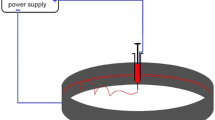Abstract
This paper presents an experimental study of the influence that relative humidity and evaporation rate have on the electrospinning process in terms of fiber diameter, process measurements, and selection of operating regime (applied voltage and flow rate) for polyethylene oxide/water (aqueous) solutions and poly(vinylpyrrolidone)/alcohol (non-aqueous) solutions. Poly(vinylpyrrolidone) alcohol solutions are studied to understand the separate influence of relative humidity and evaporation rate. Correlations are developed that relate measurable process parameters (jet diameter, charge density) as well as relative humidity and evaporation rate to fiber diameter. In addition, the influence that relative humidity has on selection of operating regime to achieve desired fiber diameter and maximum production rate is presented.
























Similar content being viewed by others
References
Doshi J, Reneker DH (1995) Electrost J 35:151
Srinivasan G, Reneker DH (1995) Polymer Int 36:195
Matthews JA et al (2002) Biomacromolecules 3:232
Matthews JA et al (2003) J Bioactive Compat Polym 18:125
Boland ED et al (2004) Front Biosci 9:1422
Kwoun SJ, Lec RM, Han B and Ko FK (2000) In: The 2000 IEEE/EIA International Frequency Control Symposium and Exhibition, 7–9 June, 2000. The Westin Crown Center, Kansas City, Missouri, USA
Wang XY et al (2002) Nano Lett 2:1273
Han L et al (2009) MRS Proceedings, Symposium WW: Polymer nanofibers—fundamental studies and emerging applications. doi:10.1557/PROC-1240-WW09-27
Mertz T et al (2011) MRS Proceedings, Symposium MM: Organic biolelectronics and photonics for sensing and regulation. doi:10.1557/opl.2011.877
Yan X, Gevelber M (2010) ASME dynamic systems and control conference, vol 2, p 51. doi:10.1115/DSCC2010-4201
Taylor GI (1966) Proc R Soc Lond Ser A 291:159
Yarin AL, Koombhongse S, Reneker DH (2007) Polymer 48:6913
Reneker DH, Yarin AL (2008) Polymer 49:2387
Yarin AL (1993) Free liquid jets and films: hydrodynamics and rheology. Longman/Wiley, Harlow/New York
Hohman MM et al (2001) Phys Fluids 13(8):2201
Hohman MM et al (2001) Phys Fluids 13(8):2221
Feng JJ (2002) Am Inst Phys. doi:10.1063/1.1510664
De Vrieze S et al (2009) J Mater Sci. doi:10.1007/s10853-008-3010-6
Tripatanasuwan S, Zhong Z, Reneker DH (2007) Polymer 48:5742. doi:10.1016/j.polymer.2007.07.045
Huang L et al (2011) J Polym Sci, Part B: Polym Phys 49:1734
Fridrikh SV et al (2003) Phys Rev Lett 90(14):144502
Helgeson ME et al (2006) Am Inst Chem Eng. doi:10.1002/aic.11056
Rutledge GC, Fridrikh SV (2007) Adv Drug Deliv Rev 59:1384
Yarin AL (2001) Am Inst Phys. doi:10.1063/1.1408260
Greenspan L (1997) J Res Natl Bur Stand A 81A:89
Yan X (2011) PhD thesis, Boston University
Yan X, Gevelber M (2010) J Electrost 68:458
Jayjock MA (1994) Am Ind Hyg Assoc J 55:230
Yarin AL (2001) Am Inst Phys. doi:10.1063/1.1333035
Shin YM et al (2001) Polymer 42(25):9955
Yu JH, Fridrikh SV, Rutledge GC (2006) Polymer 47(13):4789
Acknowledgements
The authors are grateful to the funding support from the NSF (CMMI0826106) and Army (W911QY-11-1-0014), and the contributions of Thierry Desire, David Ouk, Sarah Provencher, Vicki Liu, and Michael Manion.
Author information
Authors and Affiliations
Corresponding author
Rights and permissions
About this article
Cite this article
Cai, Y., Gevelber, M. The effect of relative humidity and evaporation rate on electrospinning: fiber diameter and measurement for control implications. J Mater Sci 48, 7812–7826 (2013). https://doi.org/10.1007/s10853-013-7544-x
Received:
Accepted:
Published:
Issue Date:
DOI: https://doi.org/10.1007/s10853-013-7544-x




